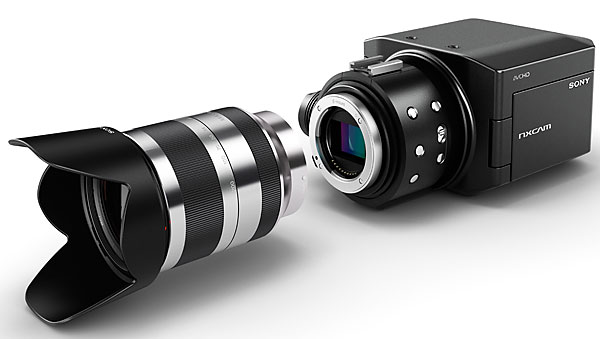Zeiss, Cosina, Sigma and Tamron – NEX E-mount future
Sony Corporation announced today it will disclose the basic specifications of its “E-mount” for interchangeable single lens cameras, without fee, to manufacturers of lenses and mount adaptors, starting April 1st, 2011. This was previously confirmed at the photokina press conference – now they have revealed that Carl Zeiss AG, Cosina, Sigma and Tamron will all be working on the E-mount system as independent lens makers.
“This opens the way for manufacturers of various lenses and mount adaptors to effectively develop products conforming to “E-mount” specifications”, say Sony.

The NEX E-mount revealed – ten contacts, three flanges and a mere 18mm of register distance…
“Users of the Sony’s NEX-3, NEX-5, NEX-VG10 and other E-mount compatible Sony digital imaging products to be launched in the future will now be able to use interchangeable lenses from both Sony and various other manufactures, while they will also be able to attach non-Sony lenses to their Sony digital imaging products via a mount adapter. Sony believes the growth of digital imaging products employing the “E-mount” will further increase the enjoyment of photography and video shooting among an even wider range of users.
“These basic specifications will be disclosed to manufactures of lenses and mount adaptors following a predefined process of approval and the signing a license agreement with Sony.
“As of today, the decision to disclose basic specifications of the E-mount has been endorsed by the following companies.”
(there follow these manufacturer statements)
Carl Zeiss AG
As an independent lens provider, Carl Zeiss welcomes the disclosure of the E-mount specifications by Sony. It helps manufacturer’s product development, benefits customers and therefore assists in establishing E-mount as a new, healthy and strong system on the market.
Cosina Co., Ltd.
Cosina Co., Ltd is excited by the potential of Sony’s E-mount which enables to a large-size image sensor to be incorporated in a compact, interchangeable lens camera. We have high expectations for the E-mount with its aims to create a new photography culture, and express its assent to Sony’s decision to provide information related to E-mount.
Sigma Corporation
Sigma Corporation fully supports Sony’s decision to disclose basic E-mount specifications. We believe this move will spur the further growth and diversification of camera system across the industry, provide photo enthusiasts with a wealth of choice and enrich in their photographic lifestyles.
Tamron Co., Ltd.
Tamron Co., Ltd endorses Sony’s decision to disclose basic E-mount specifications. We aim to offer our customers new solutions and unprecedented photo-shooting enjoyment through the manufacture and sale of E-mount lenses.
Editorial comment: at the photokina conference, the wording used seemed to imply that independent E-mount camera bodies were also a possibility. Of the makers above, three already have a history of making rangefinder or compact style large sensor bodies – Zeiss (to date, film only); Cosina (digital, in the form of the Epson Leica mount bodies with 6 megapixel Sony sensors) and Sigma (the DP-1 and 2 series have fixed lenses, but would be a natural candidate for conversion to E-mount form). If this was to be the case, in a future announcement, the E-mount would be established as an alternative to the Micro FourThirds system with a capacity to use sensors in formats between 2X and 1.5X with existing lenses, and possibly up to full frame in a secondary configuration with a different range of lenses (backwardly compatible with smaller sensors).
Is this the same Sony people rant about being protective and exploiting their customers? No. It is Sony listening to their customers. It’s Alpha becoming the 21st century equivalent of Leica.





